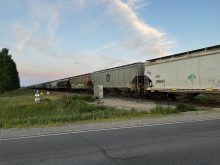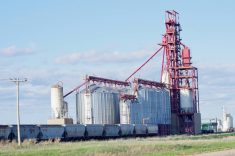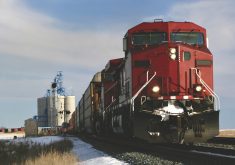A group in southern Alberta has taken back a section of a short line rail, and area communities are enjoying the dividends.
“We started Forty Mile Rail back in 2016,” said Lorne Buis, a director of the 75-kilometre-long rail line that runs from Stirling to Foremost.
Last month, the group received $4.2 million of federal funding for infrastructure projects, which will grow to $9 million with private-sector investment.
“The fund is a match grant, so we have to spend the money first. We spend $100,000, they’ll match the $100,000,” said Buis, who is also mayor of Foremost. “The money can’t be used to buy more rail, or more property. It has to be used for upgrades.”
Read Also

Farming Smarter receives financial boost from Alberta government for potato research
Farming Smarter near Lethbridge got a boost to its research equipment, thanks to the Alberta government’s increase in funding for research associations.
Forty Mile Rail was born when a group decided to purchase the rail line and contacted local farmers, Hutterite colonies and area businesses to become shareholders. They eventually raised the money to buy the rail line, which had been abandoned in 2006, and became the province’s second privately owned short line railway (the other is the Battle River Railway).
But their business plan soon needed changing.
“We bought the rail line with the intention of shipping grain,” said Buis. “With the dissolution of the wheat board, it kind of made sense.
“Now we have had three years of drought, and not a lot of grain, so we’ve been trying to find other ways to generate income
The group didn’t have to look very hard, as they’ve had a lot of interest from other businesses.
“People now want to import products in and offload on our rail. At the time, we didn’t have the sidings for it. So that’s our plan. We’re going to put in two sidings, possibly three, that can handle train units.”

There is one siding area at Foremost, but that’s not enough for a unit train, which has generally meant 112 rail cars. But the unit trains are getting longer and so the plan is to increase the current siding to 136 cars.
“Our goal down the road in the future is to be a 150-car unit track — it just takes a lot (of land),” said Buis.
“We’re looking at doing another one at Judson Flat, close to the west end of our line.
“That will allow for more efficiency. If we have a full train, then it could be pushed up into railyard and go by it, so they don’t have to jockey each other and move things around. It increases the fluidity of the rail line.”
And even though they’re one of the little guys, Forty Mile has to be able to run with the big dogs.
“Our biggest concern and why we want to go to the unit trains is that CP and CN have all gone to the hook-and-haul strategy where you put the train on for them, and they hook onto it and pull it straight to the coast,” said Buis. “They don’t want to have to build trains in their railyards. It’s efficiency on their part. We’re looking to be more efficient as well.”
Efficiency doesn’t mean compromising safety. It currently takes about three and a half hours for the train to travel from Stirling to Foremost at about 12 miles an hour.
The CN and CP rail connections are at Stirling, which connects to the Coutts mainline (running from Coutts to Lethbridge).
But with grain shipments not being as robust as hoped, Forty Mile has adapted.
Part of the planned upgrades is an expansion in the trans-load yard to store wind generator components.
The former NDP provincial government announced five wind farm projects in southern Alberta about three years ago, and Forty Mile Rail is being used to haul parts from the U.S. The blades made in Brighton, Colorado, delivered to Sweetgrass, Montana, transferred to CP and then offloaded at the short line’s Foremost yard because the big railways don’t want to offload the components on their mainlines.
“I understand this,” said Buis. “They want to keep their lines moving.”
And this is no small business. One wind farm north of Foremost has brought in 880 carloads of components.
“That’s a huge boost of income to our railyard, compared to shipping 300 carloads of grain out,” said Buis.
Another company is looking to import U.S. corn into the Lethbridge area, using Forty Mile Rail on the Canadian end, where it can offload the grain onto semis, and then go to feedlot alley around Lethbridge and Fort MacLeod. Other grain companies have expressed interest in buying durum, peas and lentils from the region.
Buis, whose town has a population of 560, embraces the benefits from purchasing the rail line.
“It’s kept the rail line open. In a small town like Foremost, if it loses its rail line, it will eventually dry up and die,” he said.
The rail line has a board of eight directors, along with three full-time and a couple of part-time employees. The workers were trained to do rail repairs and replace ties, so other contractors don’t have to be brought in.
Forty Mile Rail has given an economic boost to the area and has helped reduced large truck traffic on the roads.
“Any small town in Alberta or Saskatchewan that has a rail line, they should look at taking it over. It’s a boost to the area economy,” said Buis.
















